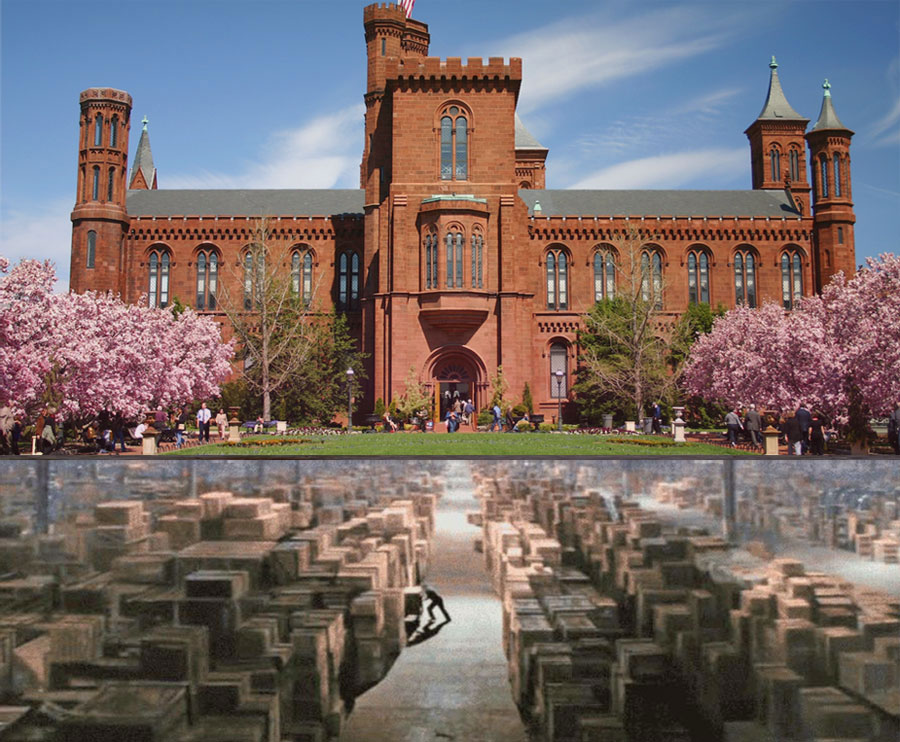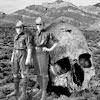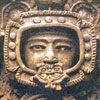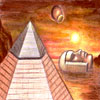Suppression By The Smithsonian
 by Jim Marrs
by Jim Marrs
What happens when unexpected archaeological discoveries beyond the norm get hijacked? Researcher and historian Martin Doutré related a conversation he had with a former National Park Service employee about an incident that took place at Arizona’s Canyon de Chelly National Monument in 1999. “A big washout had occurred in the canyon after torrential rains, and a number of skeletons were exposed at a few sites. All of the Park Service personnel were pressed into service to gather up and box up the newly revealed bones. However, in a somewhat sinister twist, all of the work was overseen by personnel from both the Smithsonian Institution and the FBI. The Parks Service workers were forbidden to bring cameras to the site and were subjected to full body searches by the FBI when arriving in the morning or leaving at night. All of the skeletal remains and artifacts were carefully boxed up and taken away by the Smithsonian Institute. The Park’s Service workers were forced to sign secrecy agreements of non-disclosure of information related to their activities in the canyon.”
In a follow-up e-mail, the former Park Service employee offered further details of the find. She said in one grave was a “male, approximately seven-foot in height, [with] six fingers and six toes … the teeth were like human, except they had no canine (eye) teeth, and [had] extra-large molars and incisors. The skull was large—heavy jaw [with a] long, large cranium. Large eye sockets. Finger bones [were] extra-long, but small hands. Buried with beautiful pottery and baskets of fine weave—never seen anything similar. A necklace of fiber and feathers. He looked rather fresh for 6,000 years old, as the Smith [Smithsonian] people claimed. Clean bones- but not brittle … ” Her description is especially interesting in light of a biblical passage, II Samuel 21:18–22, telling of giants related to Goliath with six fingers and toes.
Some believe the Smithsonian has a huge underground warehouse in New York City, filled with thousands of skeletons, objects, and information that might prove embarrassing to conventional history.
“It’s appalling that the American people are so blatantly denied access to very important archaeological evidence, which would quickly clarify mysteries related to long-term regional history,” said Doutré. “Whereas North American archaeology has been stagnated or has gone backwards for 130 years, all of the essential evidence is in the hands of the authorities to rectify that abysmal situation, but is kept permanently under wraps and beyond the reach of the socially-engineered American public.”
The late Vine Deloria, an activist historian and author of the 1969 book Custer Died for Your Sins: An Indian Manifesto, also charged the Smithsonian with suppression of valuable historical information. “It’s probably better that so few of the ruins and remains were tied in with the Smithsonian because they give good reason to believe the ending of the Indiana Jones movie—a great warehouse where the real secrets of earth history are buried,” he wrote. “Modern day archaeology and anthropology have nearly sealed the door on our imaginations, broadly interpreting the North American past as devoid of anything unusual in the way of great cultures characterized by a people of unusual demeanor. The great interloper of ancient burial grounds, the nineteenth century Smithsonian Institution, created a one-way portal, through which uncounted bones have been spirited. This door and the contents of its vault are virtually sealed off to anyone but government officials. Among these bones may lay answers not even sought by these officials concerning the deep past.”
British scientist James Smithson first founded the Smithsonian Institution and then bequeathed it to the United States despite having never visited there. Since the U.S. Government started funding and administrating the Smithsonian in 1836, the institution has been involved in several disputes over odd discoveries. In the early 1800s, pioneers moving into the Ohio and Mississippi valleys discovered vast numbers of abandoned earthworks, generally termed mounds. The pioneers attributed these mounds to a sophisticated race of long-vanished builders. In 1848, the new Smithsonian Institution drew attention to the mystery of the mounds’ creation in its first published book Ancient Monuments of the Mississippi Valley. The book’s authors concluded that the builders could not have been the ancestors of the supposedly savage Native American groups still living in those regions.
According to David Hatcher Childress, an author and a world-traveling researcher on ancient cities and cultures, the contents of many ancient mounds and pyramids of the Midwest show that an ancient and sophisticated culture once populated the Mississippi River watershed. Not only had this culture been in contact with Europe and other areas, but, according to Childress, many mounds revealed burials of giants seven to eight feet tall, dressed in full armor, sometimes buried with huge treasures.
In 1924, a paleontologist discovered skeletons of red-haired giants in the Lovelock Cave of Nevada, confirming Indian legends that a race of red-haired giants lived there about fifteen thousand years ago. According to legend, the giants were already in the area when the first Indians arrived. These giants were reputed to be vicious and unapproachable cannibals. During ensuing wars, the giants were decimated and finally cornered in the cave. When they refused to surrender, the Indians filled the entrance with brush and set it afire. The giants who tried to escape were shot with arrows and the others suffocated in the cave.
Beginning in 1911, the cave was worked for its bat guano to be used in making gunpowder, and most of the remains were destroyed. But an expedition in 1924 did recover the mummified remains of two giants—a female six and a half feet tall and a male more than eight feet tall. Reportedly, artifacts from the cave, but not the mummies, may be viewed at a small natural history museum in Winnemucca, Nevada.
How strongly are we to believe that races before our own were actually much larger than we are today, especially when supporting evidence has been wiped from textbooks? Another episode illustrates Smithsonian suppression of historical artifacts. The late naturalist and author Ivan T. Sanderson told of an incident during World War II on the Aleutian island of Shemya in which engineers building an airstrip uncovered the remains of gigantic humans. One cranium measured almost twenty-four inches from base to crown, compared to the normal eight inches. Oddly, all the skulls showed evidence of trepanning (poking holes in the skull with crude tools to release evil spirits). The remains were reportedly sent to the Smithsonian, which, despite the seeming importance of such a find, never released any further information. Sanderson asked, “Is it that these people cannot face rewriting all the textbooks?”
The Smithsonian has been involved in several other controversies over eyebrow-raising discoveries, such as the objects found in 1944 by German hardware merchant Waldemar Julsrud at Acámbaro, Mexico, located about 175 miles northwest of Mexico City. In 1923, Waldemar was a co-discoverer of an archaeological site first thought to be of the Tarascan culture. This discovery brought worldwide attention after it was found to actually be a whole new Indian culture—the Chupicauro civilization, which flourished in Mexico about a thousand years before the Tarascans.
Julsrud’s 1944 find consisted of more than thirty-three thousand ceramic and stone objects, including statues and obsidian knives. The amazing aspect of the statuary was the fact that the carvings depicted humans in association with large reptiles resembling dinosaurs. Along with other weird creatures, there were representations of Sumerian and Egyptian motifs, as well as bearded Caucasians, Africans, and Polynesians.
Although radiocarbon and thermoluminescence testing indicated that the objects could be dated as far back as 6,500 years, Smithsonian officials quickly proclaimed the entire episode a hoax. In recent years, when researcher John H. Tierney filed a Freedom of Information Act request, it was learned that all of the Julsrud case files at the Smithsonian were missing.
Dennis Swift, on his website Dinosaursandman.com, has written of visiting Acámbaro. He noted, “Waldemar, in print [his book was published in 1947], theorized that the colossal collection of ceramic and stone artifacts had been buried by a people who had experienced catastrophes. He conjectured that there had been a period of catastrophes that had changed the face of the earth, and that there must have been ancient civilizations wiped out by the catastrophes. His most radical suggestion that clashed violently with scientists was that man had existed contemporaneously with the dinosaurs. Although there was sound evidence that Julsrud was on to something of major scientific importance, he was ridiculed by the authorities when his book was published.”
In 1955, Charles Hapgood, then professor of history and anthropology at Keene State College of the University of New Hampshire and author of Earth’s Shifting Crust and Maps of the Ancient Sea Kings, spent several months in Acámbaro studying the Julsrud collection. To eliminate the possibility the collection was merely a modern hoax, Hapgood located a house that had been built at the same location in 1930.
According to Dennis Swift, “They found a house directly over the site owned by the Chief of Police and asked permission to dig beneath the floor of his house. Permission was granted, and they dug a six-foot-deep pit beneath the hard concrete floor of the living room, unearthing dozens of the controversial objects. Since the house had been built twenty-five years previously, it exonerated Julsrud, eliminated the hoax theory, and negated [two reports alleging fakery] at all the important points.”
One enduring mystery—or conspiracy—stems from reports of the discovery of ancient Egyptian artifacts in the north end of the Grand Canyon at the beginning of the last century. According to a front-page article in the Phoenix Gazette of April 5, 1909, an expedition funded by the Smithsonian Institution had begun work following the discovery of a “great underground citadel” in a cave “some 42 miles up the [Colorado] river from the El Tovar Crystal canyon.”
The article stated that a thirty-year employee of the Smithsonian, identified as G. E. Kinkaid, had discovered the cave a few months earlier while boating on the Colorado River. The cavern was nearly inaccessible: the entrance was 1,486 feet below a sheer canyon wall.
Once inside, Kinkaid found mummies and relics that he shipped to Washington, D.C. Quoting from a report by Kinkaid, the Gazette wrote, “On all the urns, or walls over doorways, and tablets of stone which were found by the image are the mysterious hieroglyphics, the key to which the Smithsonian Institute [sic] hopes yet to discover. The engraving on the tablets probably has something to do with the religion of the people. Similar hieroglyphics have been found in southern Arizona. Among the pictorial writings, only two animals are found. One is of prehistoric type.” Kinkaid’s report also noted that in one large room were mummies, all male and all wrapped in a “bark fabric.”
Other rooms contained cooking vessels and storage places, and one room that smelled “snaky” seemed to be filled with gas or chemicals. It was estimated that as many as fifty thousand people could have lived in the caverns comfortably. According Kinkaid’s report, “The whole underground installation gives one of shaky nerves the creeps.”
The Gazette article also related that another Smithsonian archaeologist, S. A. Jordan, was making additional searches of the cave and had discovered evidence strongly indicating that the cavern had once been inhabited by a race “of oriental origin, possibly from Egypt, tracing back to Ramses.” The scientists had discovered several hundred rooms, linked by passageways running from the main passage. Some of these rooms included “articles which have never been known as native to this country, and doubtless they had their origin in the orient. War weapons, copper instruments, sharp-edged and hard as steel, indicate the high state of civilization reached by these strange people.”
The article’s conclusion was shocking. It argued that if the archaeologists’ theories were “borne out by the translation of the tablets engraved with hieroglyphics, the mystery of the prehistoric peoples of North America, their ancient arts, who they were and whence they came, [would] be solved. Egypt and the Nile, and Arizona and the Colorado [would] be linked by a historical chain running back to ages which staggers the wildest fancy of the fictionist.” Unfortunately, the century-old Phoenix Gazette article seems to be the only real evidence that this discovery ever took place. Some have called the story a planted hoax, and officials at the Smithsonian continue to deny involvement in any such expedition or that Egyptian artifacts have ever been recovered in the canyon.
But the mystery lingers. One young man, who did not want his name involved in this matter, related in the late 1990s that he was backpacking in the north end of the Grand Canyon when he came across concrete platforms. Knowing of the Egyptian artifacts story, he surmised that the platforms may have been the base for cranes to lower heavy artifacts from the cave on the sheer rock face. David Hatcher Childress, who founded the World Explorers Club, looked into the matter. After obtaining a map of the Grand Canyon, Childress and club members reported:
Poring over the map, we were amazed to see that much of the area on the north side of the canyon has Egyptian names. The area around Ninety-four Mile Creek and Trinity Creek had areas (rock formations, apparently) with names like Tower of Set, Tower of Ra, Horus Temple, Osiris Temple, and Isis Temple. In the Haunted Canyon area were such names as the Cheops Pyramid, the Buddha Cloister, Buddha Temple, Manu Temple and Shiva Temple. Was there any relationship between these places and the alleged Egyptian discoveries in the Grand Canyon?
We called a state archaeologist at the Grand Canyon, and were told that the early explorers had just liked Egyptian and Hindu names, but that it was true that this area was off limits to hikers or other visitors, because of dangerous caves. Indeed, this entire area with the Egyptian and Hindu place names in the Grand Canyon is a forbidden zone—no one is allowed into this large area. We could only conclude that this was the area where the vaults were located. Yet today, this area is curiously off-limits to all hikers and even, in large part, park personnel.
The Vatican has been long accused of keeping artifacts and ancient books in their vast cellars, without allowing the outside world access to them. These secret treasures, often of a controversial historical or religious nature, are allegedly suppressed by the Catholic Church because they might damage the church’s credibility, or perhaps cast their official texts in doubt. Sadly, there is overwhelming evidence that something very similar is happening with the Smithsonian Institution.
Excerpt from Our Occulted History
Posted in Other Topics, True History of Manwith comments disabled.





